“Ok, we have the set-up established to support reforestation with water-retention landscaping. Now we can plant the trees on your land,” I said.
“But now I’m broke,” was the landowner’s reply.
Our response was to raise some money with a theatrical art auction and dance party. The Yupaichani Network was born! In the Quechua language, Yupaichani means “Thank you, Pachamama”. Pachamama includes the Earth, the Sky, the Cosmos and all of time.
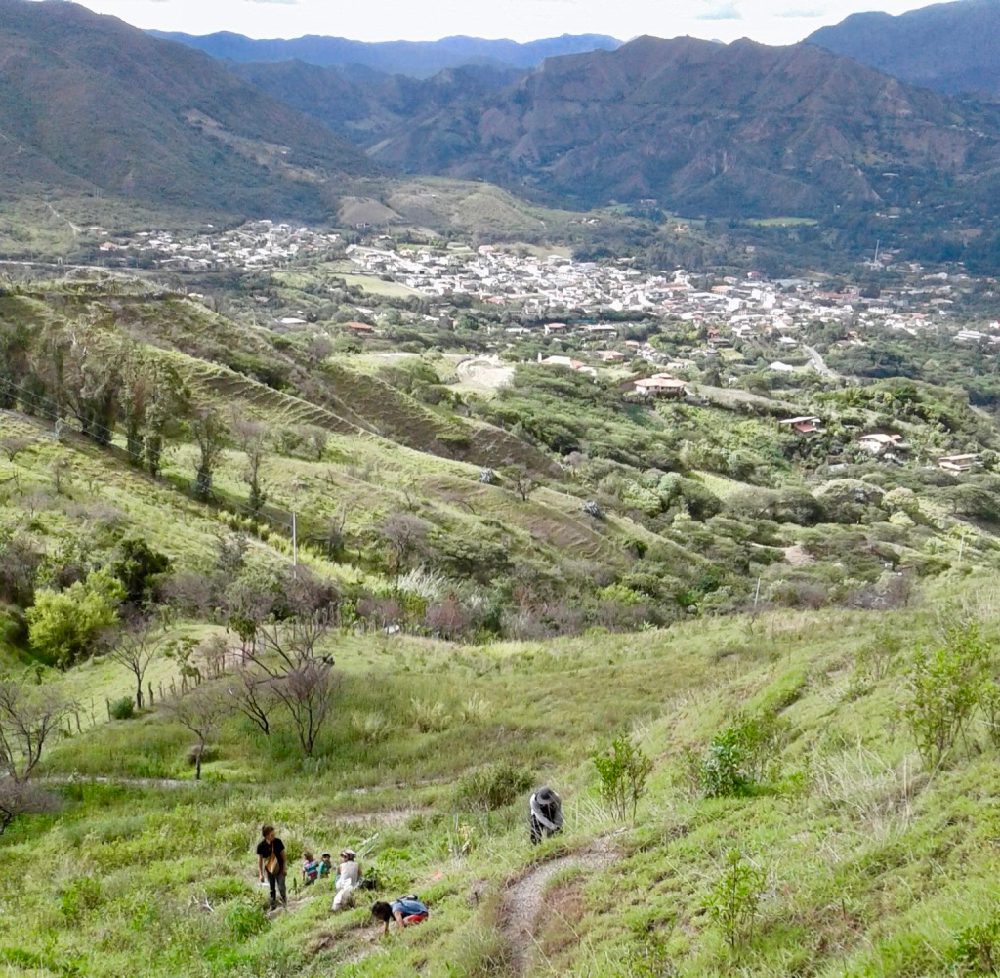
In these times of economic, climate and political challenges, how do we move forward toward the world we collectively long for? Undaunted by language and cultural differences, this is a story of community collaboration, with the important ingredient of persistent insistence on the goal of ecosystem restoration.
Vilcabamba is a small town in Southern Ecuador, with slopes running West to the Pacific Ocean, and to the East to the Amazon basin. In part because it is at a low point in the Andean cordillera, Vilcabamba has one of the highest rates of biodiversity anywhere. It supports species from the country’s three principal climate zones:the coastal plain, Amazonia and the sierras.
Lea este artículo en español aquí
In Incan times, Vilcabamba was used as a place of restoration and healing for the Incan royalty, and is still known as the ‘Valley of Longevity,’ for the health benefits of its pure water and air. In recent times, these qualities have also drawn tourism from national and global travelers alike, and people from over 60 countries have taken up residence here. Marisol Delgado, the co-owner of a popular grocery story on the main plaza, comments: “It means we have a different culture here. The extranjeros (foreigners) have helped the economy and also have brought many projects that help the local people.” Generally the cross-cultural ambiance is quite amicable.
Working in collaboration with local gardeners and farmers as well as finding inspiration in national groups such as Red Guardianes de las Semillas (the national seed saving network of Ecuador) and the organic farmer’s associations, many of the new “transplants” are working hand-in-hand with the unique variety of homo sapiens that is arising all over the world to help shepherd the full circle that agriculture is making, coming back to regenerative practices that respect and listen to nature.
In 2008, Ecuador was the first country in the world to officially recognize the rights of nature. In its constitution, Ecuador names nature’s “right to exist, persist, maintain and regenerate its vital cycles.” In Ecuador, nature can win a lawsuit.
Conversely, Ecuador also has some of the world’s highest rates of deforestation, estimated at over 300,000 hectares (3 percent) per year. Before major human impact, Ecuador was estimated to have 65 million acres of forested land. Now it has 9.8 million acres of forested land. Only 16 percent of the original forests remain. Between 2001 and 2014, 600,000 hectares was lost to lumber extraction, grazing land and runaway fires.
Ecuador straddles the equator on South America’s west coast. Its diverse landscape encompasses Amazon jungle and the coastal plane, with the Andean highlands between these two lowlands. There is also the wildlife-rich Galápagos Islands. The Ecuadorian Andes are host to four massive volcanoes of over 5,700 meters. The topography is extreme, making most of Ecuador inaccessible to industrial machinery—one of its saving graces, keeping the agro-petro giants at bay, at least in the highlands. The Andes are mostly farmed with hand tools, by those living a subsistence lifestyle, by both indigenous and mestizo people.
As in much of the world, people are abandoning the agrarian life for the cities.
See related story, Lino’s Dream: Creating a Kañari Future Based on Tradition in the Ecuadorian Andes, by Alan Adams.
In 2017, a wildfire swept across Vilcabamba’s southern mountain face where the San Jose barrio is located. When the fire laid those hills bare, the dueño (owner) of the property called El Mirador asked me, Zia, for a permaculture plan to deal with the erosion that threatened his property. This crisis was the perfect opportunity to introduce water retention landscaping as a stair-step towards reforestation. As a permaculture designer and teacher I had directed an agro-forestry program in West Africa and taught in many Permaculture Design Courses, including on the Navajo Reservation.
,
In 2013, my husband Roshni McEldowney, a teacher of Rudolf Steiner’s biodynamic agriculture system, and I had packed up our farm in my home-town of Boulder, Colorado, USA, where local laws made it difficult to practice and teach permaculture. We moved to Ecuador. In just seven years, what we have been able to accomplish is light-years ahead of what we could realize in Boulder, both in terms of creating a permaculture model on our small farm, and in terms of working in collaboration with neighbors and local government officials to go beyond our own “backyard” to support healing of the surrounding ecosystem and economy. The rainwater conservation design at our farm, Finca Vida Verde, can be seen in this video (which has over 85K views).
I had been bringing our annual Vilcabamba Permaculture Design Class (PDC) up a ridge trail above our farm to observe the headwaters of this important watershed for the area. Our students created “flash-designs”, that is, quick design sketches, of earthworks that could help preserve that watershed and minimize the severe erosion that occurs downstream. I had been dreaming of reforestation supported by water retention landscaping on this watershed. It was also ideal because the spot was very visible when entering the valley from the nearest city, Loja. When this side of the valley started to green up with new plantings, it would create an eye-catching message to support our Rehydrate<>Reforest Project from across the valley.
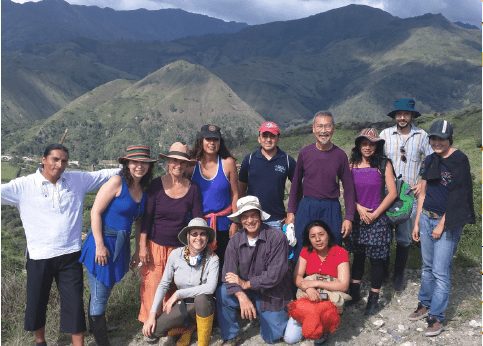
Following the fire, in the fall of 2017, I directed a strong and agile crew of local indigenous Saraguro workers to implement my Water Retention Landscaping plan at El Mirador. Approximately 800 meters of diversion swales — which are contour canals with a slight slope inside the canal — were part of the design for spreading water across the slope. In permaculture, we say that when water is running, we ask it to walk—that is, to slow it down so it can penetrate the land. A tremendous amount of water can be stored in the land this way. Often referred to as “rainwater harvesting”, both swales and keyline design are important tools in permaculture for mimicking the conditions of a mature ecosystem, which will allow rainwater to soak into the ground. When working on a design in the Otavalo area in Northern Ecuador for the Quechua people, I began using the term agua ayni for these types of methods. The best translation in English for the Quechua word ayni is “reciprocity”. In these methods, we are giving water back to the land. The land will restore the water to springs and aquifers and the full water cycle.
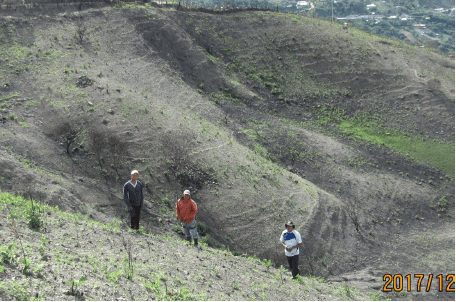
Innovation in Rainwater Management. This design was pushing the envelope on permaculture standards for digging diversion swales on steep slopes. A common recommendation for creating swales is maximum slope of 30 percent, but some of these slopes were as much as 70 to 80 percent. Thus we created very narrow swales, only 20 cm wide and 20-30 cm deep, with more of a slope than usual within the canals, to move water more swiftly off the mountain. When collecting water in any form the risk of destabilization from water weight must be considered. However, our experience has shown that steeper drops within narrower swales is the adaptation that is needed. Being in a sub-tropical climate zone, we added the stabilizing strength of vetiver grass below the swales, which forms a strong subterranean network 4-5 meters deep, and also forms an above-ground barrier. Vetiver (link Vetiver.org) is extraordinary for slope stabilization, and has many other benefits. If these small swales fill with sediment, the vetiver will continue to act as a barrier to hold soil nutrients and a channel for the water. These swales were measured precisely with a water level that costs about $5 to make, to a 0.8 -1.20 degree slope to take water away relatively quickly from the two major ravines as a strategy for spreading the water out and arresting erosion.
These swales held up during the winter rains of 2017, and as the rains of 2018 approached, I spoke with El Mirador’s dueño (landowner) once more. “It’s time to plant trees,” I said. “I’m broke,” was his reply.
Rallying friends that had been involved in five related projects, in November 2018, the Yupaichani Network was launched with a theatrical art auction and dance party. In Quechua, Yupaichani means, Thank you, Pachamama! Pachamama includes the Earth, the Sky, the Cosmos and All of Time.
We needed some cash to support the planting of these trees on El Mirador, and there were four other projects, in various stages of gestation, that were needing some support. We decided to launch a fundraising effort with a party, to see if there was local support for these projects to take wings and fly. The need to get those trees in at the beginning of the rainy season, in November/December, was pushing us to go into action.

With that first fundraiser, the Yupaichani Network raised money to go forward with planting 800 trees at El Mirador. The trees were donated by the government reforestation project of the Loja Municipality. We organized six mingas (traditional neighborhood volunteer work parties) to plant the trees. Transportation of the trees and the volunteers and making compost for the trees cost the project $500. At that point, the owner matched us. He had already made a significant investment in installing the swales and Vetiver.
The five projects of the Yupaichani Network are: 1) protecting seed biodiversity, 2) rehydrating and reforesting the valley of Vilcabamba, 3) an herbal medicine and seed collective, 4) a land collective and eco-arts school, 5) digital mapping of organic corridors. Our first fundraiser also provided cash for designing branding and packaging for the newly formed women’s herbal medicine collective, as well as sending representatives to the annual national seed-saving meeting and sponsoring the biannual seed exchange at the Vilcabamba Organic Market.
The Yupaichani Network is a consortium of friends and associates that are working together on five local initiatives that address global problems. It is a model for local ecological and economic regenerative action. Respecting water and giving back to the land are two of the primary values. We need to go beyond our backyard, beyond property lines and onto the canvas that Chief Joseph of the Nez Perce indigenous nation was talking about when he famously said, “The land does not belong to us, we belong to the land.”
Seed sovereignty is one of the network’s primary concerns. Since 2014, and various points of action since, a cross-cultural group of concerned citizens had been working to protect seed sovereignty and Ecuador’s constitutional ban against planting GMO seed.
One day, Carolina Bermeo, Andrea Espinosa, Zia Parker and Annie Eagleton were enjoying time together at Andrea’s house. We had all worked on the PDCs together. We were bonded as eco-activists. We heard of a proposed law threatening Ecuador’s constitutional ban against planting GMO seed. With the growing evidence of human health and environmental damage caused by GMO seeds, we were determined to protect Ecuador’s constitutional ban against planting GMO seeds.
Oh no! Not this issue again! We’ve got to act on this. And we’ve got to make it fun, or we will just lose our minds! So we pulled in art and music and fun by making Seed Mandalas to create newsworthy events around this issue. Coincidentally, the Peace and Dignity Intercontinental Relay Run was soon coming through Vilcabamba.
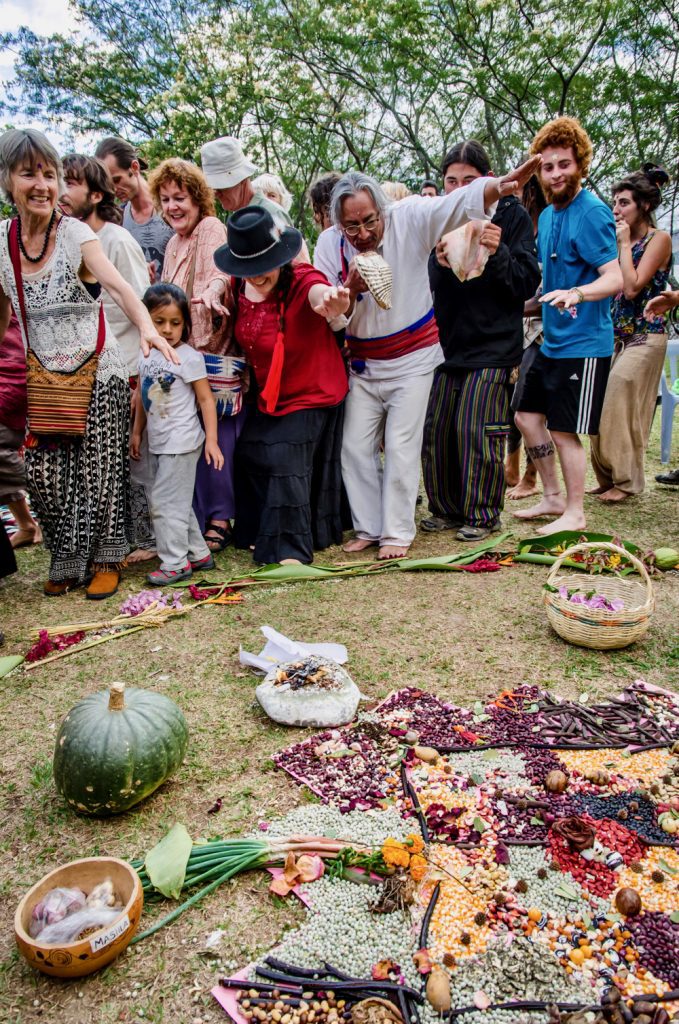
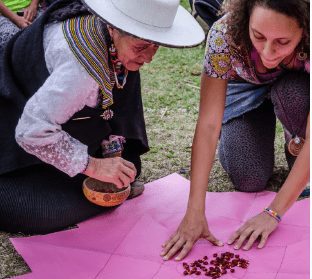
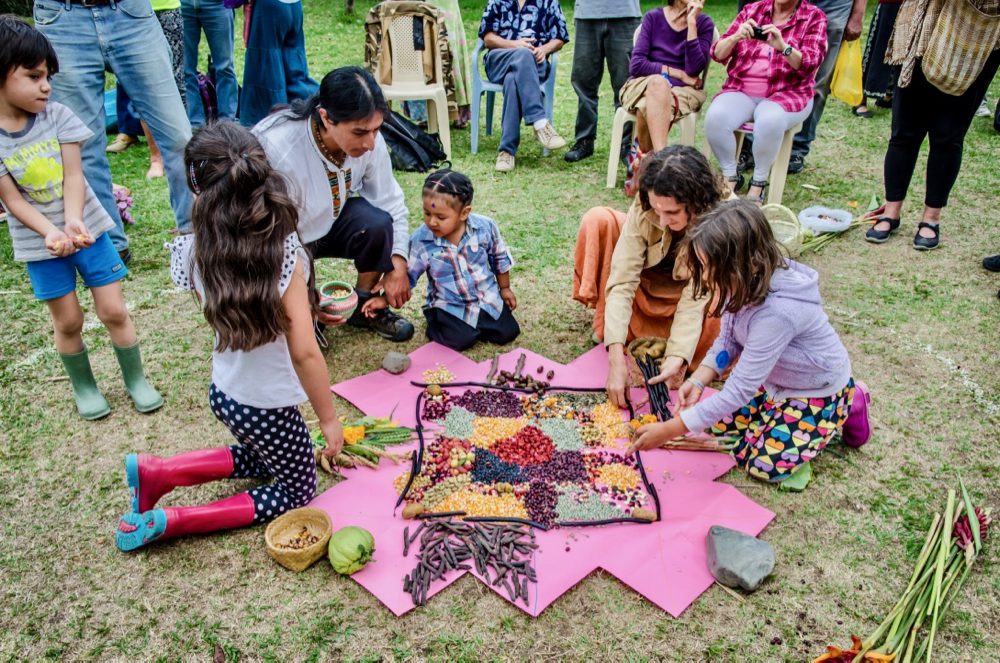
Runners began simultaneously in Tierra del Fuego and Alaska to begin a relay run to Panama, running for peace. As the runners came through Vilcabamba, in early October of 2016, we organized to create and film our first Chakana Art Action. The chakana is recognized as a sacred cross symbol throughout the Andes. Then we distributed the video to encourage other communities to join us on the actual day of the protest.
It was a great party and the action helped raise the consciousness of many. There were five towns in Ecuador participating in the event and more communities in five countries that joined us in creating seed art in public places, with music, singing and printed literature to raise awareness of the GMO issue. Activists across the country rallied on this issue, and we were successful in turning back the law.
In Vilcabamba, the Chakana Art Action event brought people together and furthered the community’s identity and branding as a regenerative movement haven. It was a seed that nurtured future regenerative work, including the Yupaichani Network.

Establishing a weekly organic farmer’s market was a natural outgrowth of this early seed work, and the organic market also serves as a seed exchange hub. The Seed Exchanges take place twice a year on the Equinox, which is an important land-based celebration for indigenous people here. The Herbal Collective brought a passion for seeds and herbal medicine together and into the realm of business in order to create income streams for many while furthering Permaculture principles. Debora Sanchez, Enma Cordero, Tanja Zirkle and myself, all members of the organic market, make up the guiding council of the herb collective. We design the formulas and make the blends. We grow what we can, and buy the rest from other members of the organic market, which maintains a peer-review organic guarantee system, which is gradually being accepted by the local and national government.
The Herbal Collective is currently working on preparing their second international order, and saving funds for legal certification for selling in public stores, rather than only in the small farmer’s markets. The Herbal Collective gives 5 percent of its profits to the Yupaichani Rehydrate<>Reforest Project. The members of the Feria Agroecologico de Vilcabamba (organic market) including the Herbal Collective, are selling seed to Red Semillas, the national seed-saving network’s new commercial seed company. Hopefully, as the herbal collective grows, it will also be able to buy herbs from the members of the seed network.
In November 2018, four local men who are sensitive Earth stewards, Jose Calva, Darwin Quispe, Victor Macas and Luis Cuenca, walked the El Mirador property with me to observe the project prior to the tree-planting stage.
They are available for consultation on Water Retention Landscaping (Agua Ayni) for reforestation or ecosystem repair. Both Victor Macas of the Saraguro and Jose Calva of the Palta, the original indigenous people of this area, were present. In ancestral times, their peoples used water retention techniques to extend the growing seasons and support the natural water cycle. We work in collaboration to explore optimal ways of interacting with the land and rain cycle. Now with the rainy season of 2019 well on its way, the three tree-counts that have been done on the El Mirador property in 2019 show an 85 percent survival rate; a 50 percent survival rate is considered to be good. Our diversion swales are looking good! Still, we would love to know about any projects that have an objective means of measuring results with or without swales.
In June of 2019, another fundraising party launched the Yupaichani Network’s Patreon page. To join our network and support these life-support projects, go here: www.patreon.com/YupaichaniNetwork
The Yupaichani Network is working shoulder to shoulder with campesinos, indigenous wisdom-holders and local government entities toward further restoration of both local ecosystems and the local economy. We are aiming at creating a model that can have a local, bioregional and global positive effect.
The 6th Vilcabamba Permaculture Design Course, from January 28-February 9, will help further the vision of the Yupaichani Network. There is a great team of eight teachers from five countries. Zia’s husband, Roshni McEldowney, a long-term student of Rudolf Steiner, will guide an evening program of the Biodynamic Agriculture Method. To join this exciting course and certificate program, go to www.vidaverde.info.
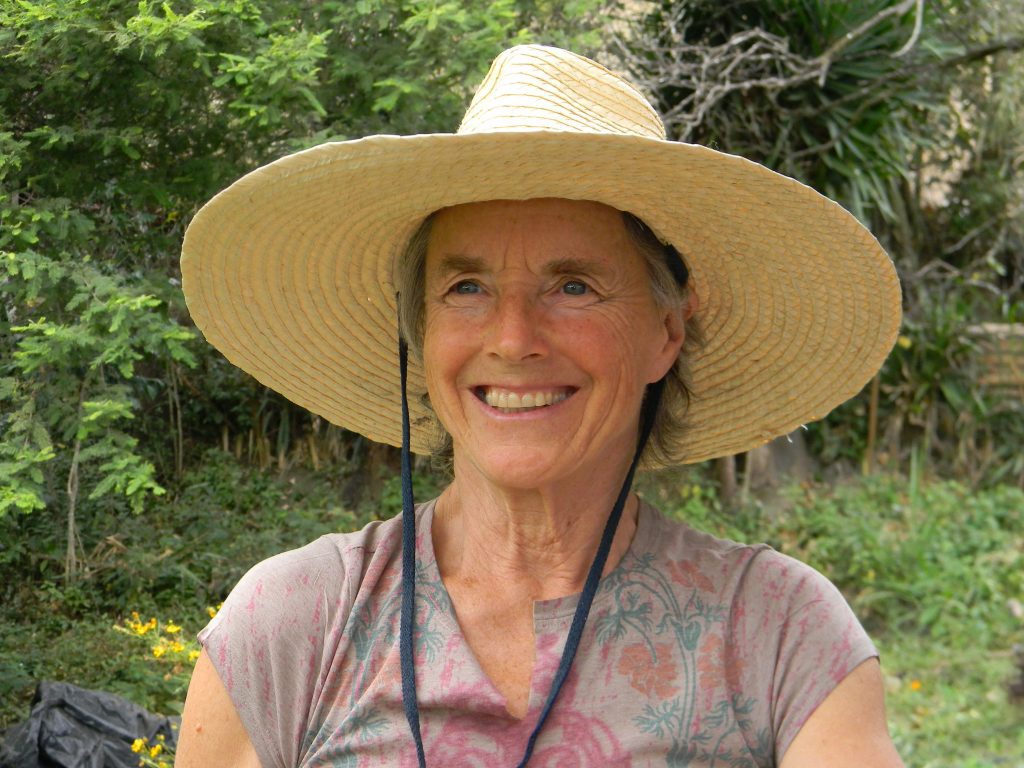
Zia Parker has helped weave together indigenous people and their knowledge with Earth-loving methodologies from the modern world in Africa, Asia and North America for over 30 years. Since “transplanting” in Ecuador eight years ago, she has continued coordinating and teaching the internationally certified Permaculture Design Course, which she has done since 1991. She provides consultation in rainwater management on private and public land. She is the founder and a current council member of the Yupaichani Network.
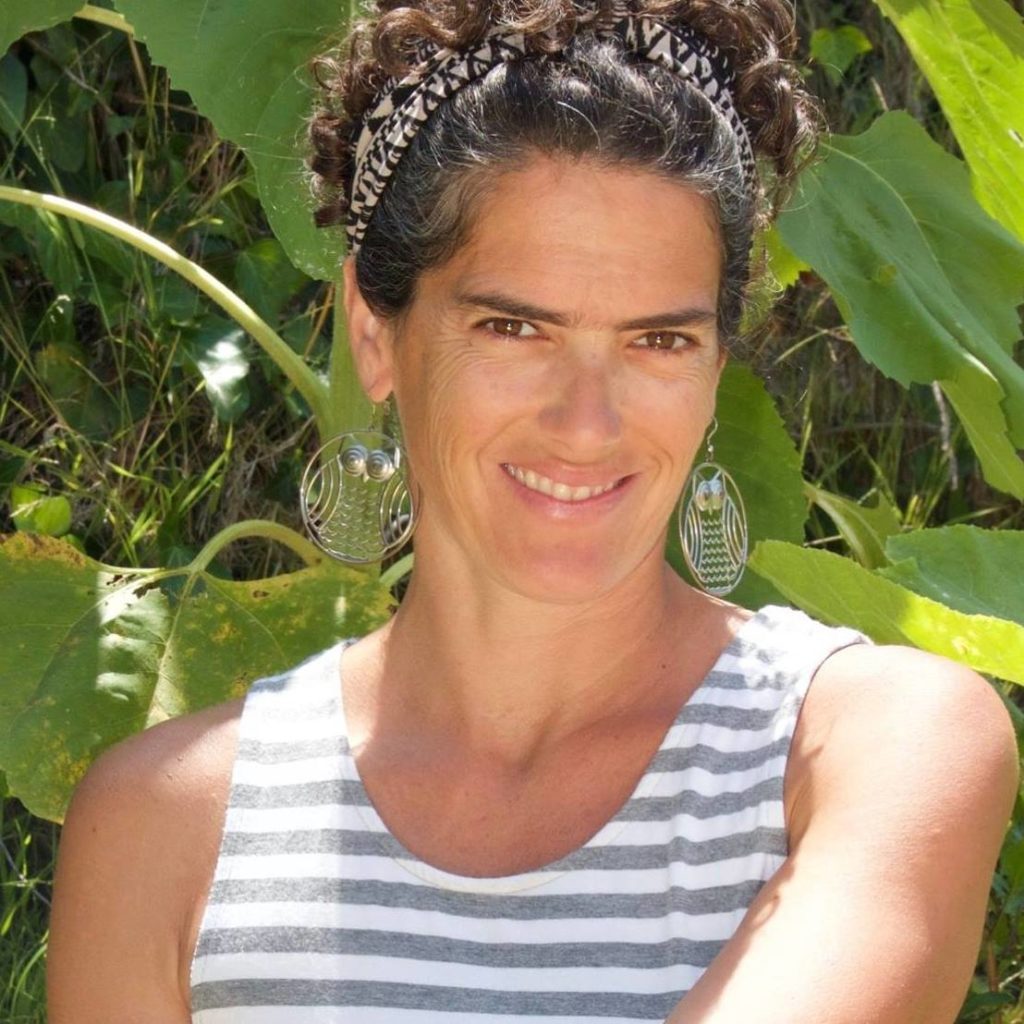
Cara H. Cadwallader is a temporary transplant to southern Ecuador by way of San Diego, California, USA.
An embodiment artist, Cara weaves her passion for education, writing, dance and art into a medicinal balm.
Aiding our aching souls, tired bodies and hungry hearts, can shift our destructive, global patterns of behavior.
Cara doesn’t know ‘how’, but she is willing to try. Join her: carahcadwallader.com
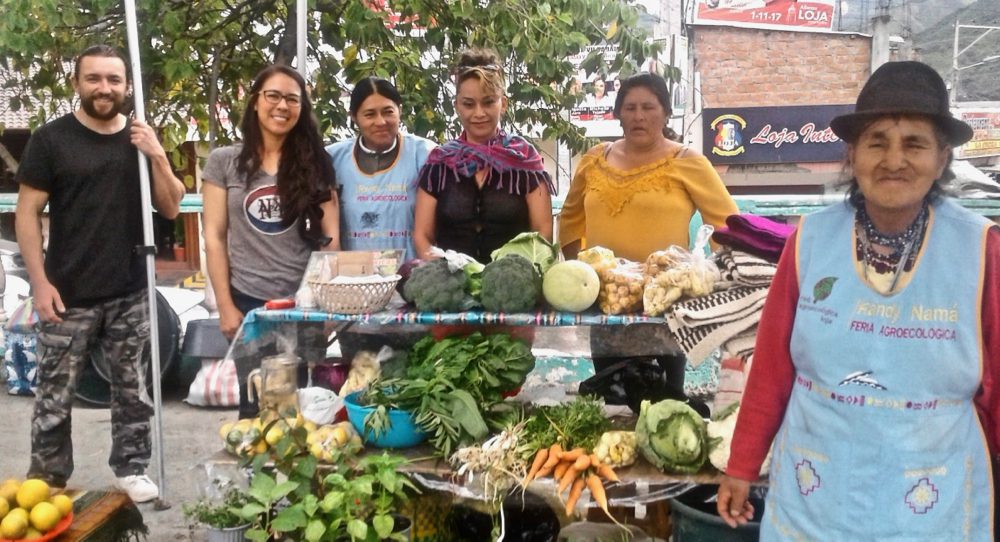
Andes keyline organic farming Permaculture Rainwater harvesting Red de Semillas regenerative farming Vilcabamba Yupaichani Network
I love what you all are doing … exciting to read about. I am delighted with what Zia and Roshni and other locals are doing on such a personal/local scale with modeling for others globally. Thank you all!
I shop regularly at the Vilcabamba organic market and have observed the development of this network. It is wonderful. Thank you to all who have participated.
Thank you Karen. The Purple Hyacinth beans you gave me at the last Seed Exchange are thriving and beautiful!
Congratulations, Zia! I think I learned about Vilcabamba from Viktoras Kulvinskas almost 50 years ago.
Boulder is obstructive as ever and becoming intolerably crowded and expensive. So glad you found a better home. I’m probably out of here after getting this project over the finish line:
https://docs.google.com/presentation/d/1Fa5lljd-R5yFs9lciXM9MnEdjeYgGw8wuUCzOhlTaCY/edit?usp=drivesdk
Thanks Evan, nice to hear from you. Zia
Thank you for sharing your work and passions with us here in Boulder!
We miss you both, Zia and Roshni, and know that you are in a place that can receive your loving kindness, hard work and wisdom.
You inspire us!
Love to you and all your comrades in the Yupaichani Network!
Sandra, Hola! Thanks for the kind words. Sending love along the Cordillera all the way to Boulder County and Arapahoe Peak!
We are all in this together! Thank you for YOUR good works! Zia with Roshni
Fantastic Zia. I loved reading this. xoxoxo
Beautiful and powerful actions you all taking. Thank you for tending the soil, sequestering carbon and making oxygen so we can all party more. Yeah to the Yupaichani Network!!
Yes, party more and….live!
And thanks to your ongoing theatrical humorous and fun inexhaustible contributions to keeping our biosphere living, dear Stele!
Dear Zia,
I’m writing to you to understand where you are today with regard to your regenerative agriculture projects. We are a group of people who through conscious business is inspired to heal the world, bigs words indeed but we are trying…
Maybe we can have a chat sometime too.
Thanks Patricio.